Do you want to have a nice looking six-pack?
But you don’t know how to achieve your goal? Which of those promising (or not so promising;)) programs should you follow?
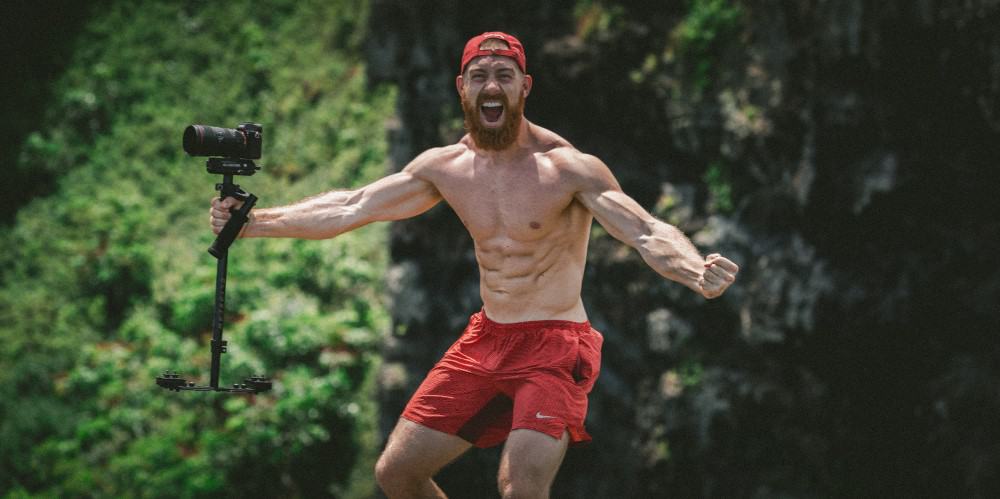
Then you want to keep reading.
There are thousands of promising programs spread all over the internet. They all have at least one thing in common; promising you results FAST!
Of course, only if with that particular brand-new program…
Is it necessary to train your abs everyday? Is it possible to get a six-pack in 3 minutes, a week or 30 days? And is burning abdominal fat only possible through intensive ab workout?
Unfortunately, these and many other misleading fitness myths are commonly spread all over the Internet. To be frank, most of them are absolute nonsense, however, a lot of people fail to recognize the real rip-off.
So, is it worth it to buy such programs?
I do not think so.
Is it all bullshit in there? Probably not everything. But most of these recommendations are either nonsense or completely misleading. There are much easier and better ways that bring you closer to your goal.
Fitness is in fact not rocket science. So, today I want to show you how every one of you can accomplish your highly desired six-pack if you commit and follow our guidelines.
They are simple and applicable to everybody!
We will clarify common six-pack myths that trap a lot of people and often result in wasting their time with inefficient things.
And last but not least, this complete guide is free for you!
In the following, we will give you (5) tips/pillars and explain to you how to get a six-pack without spending your valuable time and money with superfluous things.
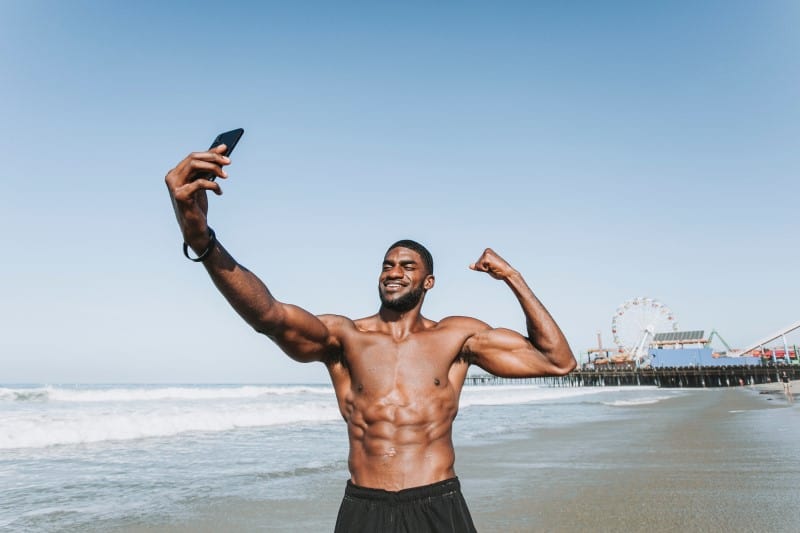
1. What should I eat to get a six-pack? Abs are made in the kitchen!
Probably this is the most underestimated aspect on your way to success.
You are trying hard to dig out that nice looking six-pack. Doing hours of cardio each week, training your abs until failure every day… but let’s be honest, does that work?
Most likely the major outcome is you wasting your time, becoming disappointed and eventually maybe even getting into a state of overtraining.
Visible (!) “abs” are mainly a by-product of low body fat percentage.
Everybody has a six-pack somewhere, but for the majority, it is hidden under layers of fat. To remove that fat and finally make your abs visible, you primarily need to focus on the right nutrition.
“I have to eat less”, is another common myth.
Unfortunately, like most myths, it’s not completely true.
Let me make something clear, if your overweight, then you definitely need to reduce your caloric consumption. However, reducing your caloric intake does not necessarily mean “eating less”!
How much you can eat depends on WHAT you eat. For example, you could eat a Big Tasty Bacon from McDonald’s which has around 900 calories.
Instead, you could eat a bowl of oats with fruits and milk (~550 calories), some chicken or beef with vegetables (~400calories) and end up with nearly the same amount of calories.
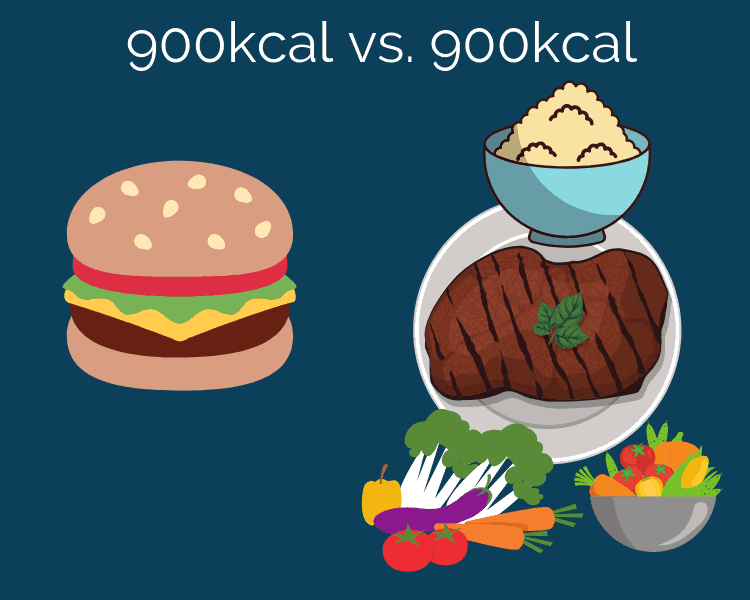
So, where’s the difference then?
Obviously, the second option is way healthier and saturating.
As you can see, it’s not only important how much we eat but rather what we eat.
You could perhaps even eat more in a diet than you used to do before if you eat the right things.
I would suggest splitting from 2-3 big meals a day to 5-6 smaller meals. This will help you stay replete over a longer period of time.
Anyhow, this is personal preference and varies individually. Try out both ways and decide what works best for you.
To illustrate that, I’ll give you an example from my last diet.
When I started dieting, I came out of a heavy bulk with around 4500kcal at its peak, each day.
During 6-8 weeks of diet, I cut my consumption in half to around 2400kcal daily.
Did I feel hungry? Was I feeling weak and craving for food?
Not at all. Surprisingly, the opposite occured.
Sometimes, I even had difficulties to eat all 2400 calories!
You might be thinking now: how is that possible with only half the amount of calories?
No rocket science, it’s very simple.
To put it in a nutshell, I made fundamental changes to my nutritional habits. Basically, I replaced the bigger amounts of high carb groceries (such as pasta, rice or bread) with a higher content of vegetables and fruits.
This served as the foundation of my diet.
But why is it so beneficial to eat lots of vegetables and fruits, especially in a diet? Well, beyond its general health benefits through its high content of micronutrients and minerals, these foods are low on calorie.
Let’s take Broccoli as an example, it solely has 35kcal on 100g… If you would add 300-500g of broccoli to each meal, the feeling of satiety will be on a different level.
In order to provide my body with sufficient protein while avoiding to eat too monotonic, I swapped between chicken, beef, fish (mainly salmon and tuna.).
So, a more or less classic low carb diet worked pretty fine for me.
But does this approach work for everyone?
I am not going to lie to you… probably not. As with most things in life, everyone is different and has their own preferences.
Therefore, I cannot emphasize it too often, but there is no magic formula that solves all your problems.
Fitness is a long steady process. In other words, it’s not a short sprint, it’s a marathon.
Overall, there is no special “sixpack diet“. As with any other sport, you should take care to maintain a healthy and balanced diet. If you already have a low body fat percentage, you probably don’t need to reduce your calorie consumption. But, for those of you who either want or need to lose weight, I’ll give you some recommendations on how to make it more easy and enjoyable.
1 – Make routine meals
Why?
If you have a pre-planned breakfast, lunch or dinner, you’re less likely tempted to eat something that does not fit into your diet.
As a foundation for my breakfast, I always eat oats with plant-based milk. On top, I add fruits like apples, bananas or my all time favorite blueberries! Furthermore, to increase variety and make it a bit more interesting, you can also add protein powder, coconut flakes or nuts.
There you go with a healthy, fast and easy prepared breakfast!
2 – Eat more fruits and vegetables
As I’ve already mentioned, I replaced large amounts of high carb with low carb foods. Fruits and vegetables do not only make you feel more saturated, by the same token they’re indispensable for a healthy body.
This way you’re able to tremendously increase the volume of your meals while keeping the overall caloric intake similar.
So, what’s the bottom line?
Staying more saturated throughout the day while being able to reduce weight and positively impacting your body.
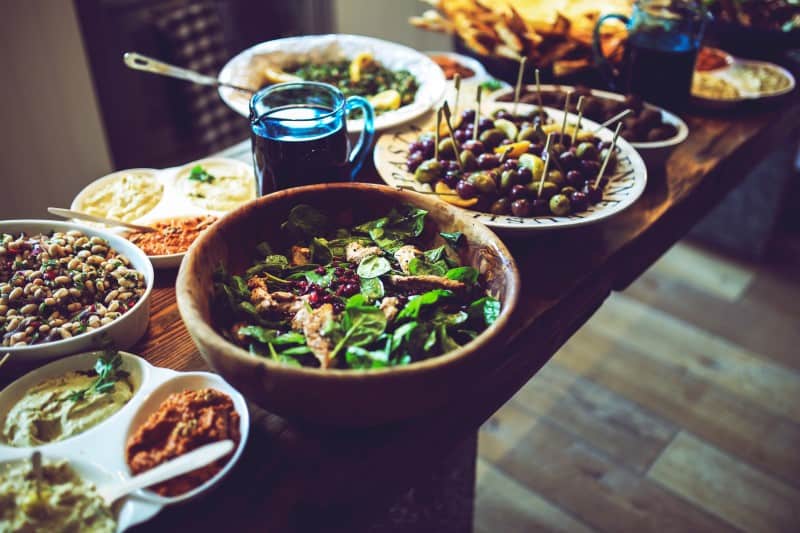
3 – Drink enough water!
Water is a fundamental foundation for all processes in your body. Being hydrated not only has positive effects on our metabolism but also, it burns some extra calories.
Furthermore, drinking enough water makes you feel saturated, which benefits your diet as well.
In fact, one study shows that drinking 500 milliliters of water increased energy expenditure by 24% for up to 60 minutes after eating.
Other research indicates that drinking water may also reduce your appetite and increase weight loss.
Another study with 48 middle-aged and older adults found out, that people who drank water before each meal lost 44% more weight over a 12-week period than those who did not.
Key take-away?
Keeping an eye on your hydration will help to stay more saturated, increase energy expenditure (burning some extra calories) and facilitating weight loss.
4 – Stop eating processed foods
Processed foods like chips, cookies, crackers, and convenience foods are high in calories, carbs, fat, and sodium.
On top of that, these foods are low in key nutrients such as fiber, protein, vitamins, and minerals.
Thus, deleting those foods from your nutrition plan will benefit you in many ways.
Firstly, it supports weight loss and reduce your fat layers. Secondly, all the vitamins, minerals and nutrients in whole foods will make you feel more saturated.
This is because it takes more energy to digest whole foods that are rich in protein and fiber as shown in several studies. So, as your body is busy keeping up its metabolism while processing those foods, additional energy is expended.
5 – Eat enough protein!
With adequate protein intake, you ensure the full functionality of your body. Not to mention that proteins are essential to support, maintain and build muscle mass.
Especially in a diet for body fat reduction sufficient protein intake is crucial to maintaining muscle mass. This prevents losing the hard-earned muscles.
One big advantage of protein is that it does not affect your blood sugar levels, as carbohydrates do. A low blood sugar level is, in turn, a prerequisite for the burning of body fat. And a low body fat percentage the prerequisite for a six-pack.
With this in mind, always pay attention that your body is sufficiently supplied with proteins.
What is sufficient protein?
Well, this is the parting of the ways… Yet, most people recommend to consume 2g of protein for each kg of bodyweight. So, if you weigh 80kg that would result in 160g of protein optimally.
In addition, our body has a hard time to break down proteins. Due to the fact that part of the absorbed energy is consumed for the breakdown of protein in its individual building blocks – the amino acids.
This is called the thermal effect. In proteins, about 20-30% of the energy is already burned in the course of digestion.
Another reason why sufficient protein supports you on your way to the desired six-pack!
10 good protein sources!
Below, I gathered some common and personal favorite protein sources that you can implement into your diet.
- Chicken breast
- Tuna
- Wild salmon
- Cottage cheese (low fat)
- Eggs
- Soy / Tofu
- Beef (low fat)
- Legumes
- Buttermilk
- Low-fat quark
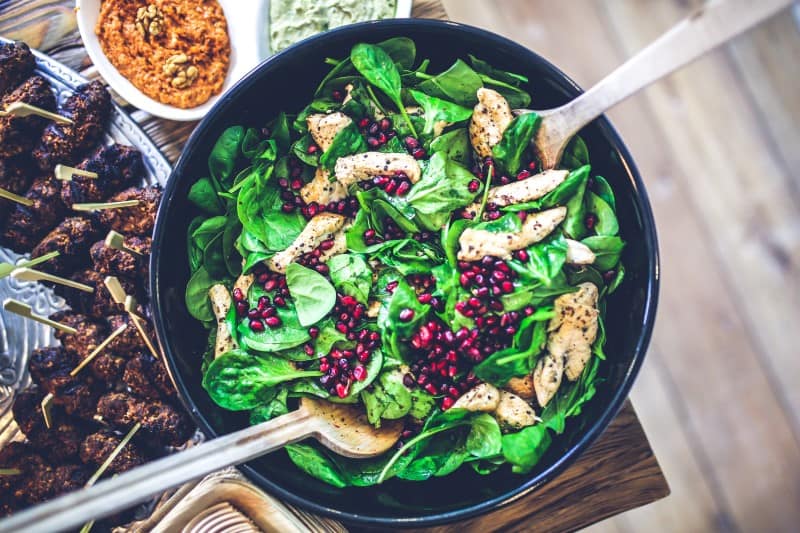
6 – Eat healthy fats!
To successfully lose weight, it is not necessary (maybe even detrimental) to completely abstain from fat. Your body needs fat to maintain healthy and strong functionality.
However, you should be aware that most of the fats you consume stem from unsaturated fatty acids. In general, unsaturated fatty acids are healthy for the body and we need them if we want to get rid of the belly fat.
Good sources of healthy fats:
- Olive oil
- Fat fish (such as salmon)
- Nuts (walnuts, peanuts, cashews)
- Coconut fat
- Avocado
- Linseed
2. How to train to get a sixpack?
The abdominal muscle is like every other muscle. If you want to stimulate optimal hypertrophy, train it with relatively heavy weights.
As a guideline, I can recommend a frequency of 2 x / week (or at least every 5th day), a volume of 2-4 sets with medium intensity of 8-12 repetitions.
While I am currently in a diet, I can tell you, ab workout isn’t as big of a factor as most people think it is. To be frank, I haven’t trained my abs isolated for months and still, since I lost some pounds, my abs became visible.
When should you train abs?
I recommend scheduling your ab workout after a lower body session. This is because the abdominal muscles have a stabilizing effect during many basic exercises (squats, deadlifts etc.).
So, generally speaking it makes sense to train them at the end of the workout. Otherwise you’re restricting your own potential by decreasing your stabilizing power when training abs before major exercises. In worst case, a sloppy execution can lead to injury.
Which exercises?
Heavy crunches are generally enough as an isolation exercise.
Yet, I would suggest to focus on exercising your core muscles instead of only doing sit-ups and crunches.
I think it’s pointless and a waste of time to do hundreds of crunches or sit-ups each day. Rather put emphasis on exercises like leg raises (hanging on a pull-up bar), planks or ab-rollouts (if you have a wheel for it)
For all these exercises, you can add weight with a belt (leg raises) or weight plate on your back (planks & ab-rollouts).
Unfortunately, many people who have a six-pack do not necessarily have a strong core. On the other side, most people with a strong core have strong abs as well. So, there certainly is a correlation between strong core muscle and a six-pack.
Furthermore, a strengthened core will help you to improve in the compound lifts such as bench press, squats and deadlifts.
So, as you can see it benefits you in various ways to focus on your core instead of doing ab isolation exercises only.
3. How long does it take to get a six-pack?
Well, I am not going to lie to you…
This cannot be answered at a flat rate.
How long it takes to get a six-pack highly depends on your starting point. Relatively speaking, somebody with a low body fat percentage of 8-12% does not need as much time compared to someone with 20-25%.
The right nutrition is fundamental (!) to accomplish your six-pack, combined with an appropriate workout, it might take some time but it’s worth it and your body will benefit in the long run.
Patience and endurance is the key.
Even though it seems like nothing really happening, don’t worry, you’ll get there!
What conditions need to be met?
To get a six-pack, you have to fulfill two conditions. Firstly, you need strong abdominal muscles. Secondly, your body fat needs to be low enough for your abdominal muscles to actually show up.
While the first point is easy to achieve with a good workout, most people have more difficulties reducing their body fat percentage. Fat loss requires a lot of discipline and patience.
Unfortunately, not everyone can manage these things. Yet, if you can manage good nutrition with appropriate training, sooner or later you will succeed, that’s for sure!
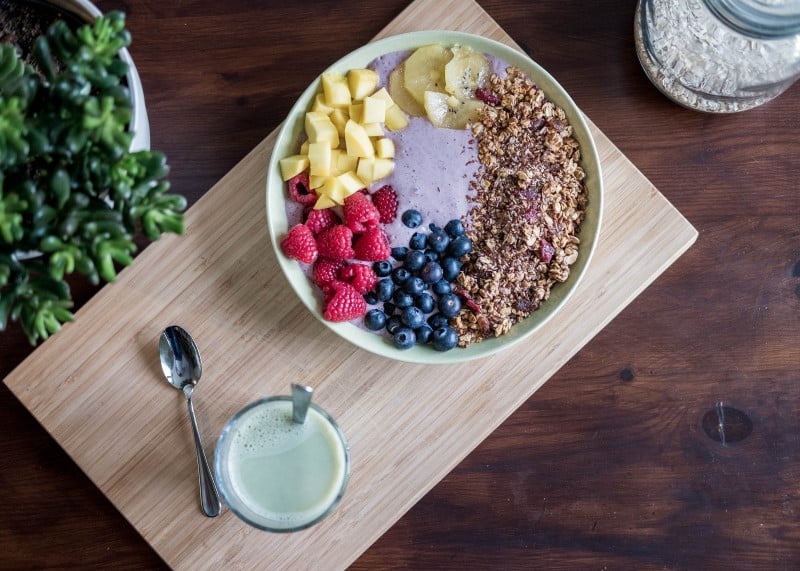
What progress can be expected?
How fast you actually lose weight does not only depend on your ambition.
Your initial starting situation also plays an important role. If you are overweight, you can usually lose weight much faster. That is because you can conduct a larger caloric deficit.
Accordingly, your body will start losing fat more quickly.
The leaner you become, the slower your progress will be. While at the beginning you may have lost 2.5 kg per week, granted you obey the rules of a proper diet, you might only manage to lose 1 kilo later on.
That is completely normal and should not discourage you.
One thing is for sure, the closer you get to your destination, the less weight you lose. As with many thing, the beginning is easy, perservering the whole journey is what really counts.
Quite often the last little cushion doesn’t want to go away for a while. Don’t get disappointed, here the formula is to keep calm and not give up. It’s only a matter of time before your abdominal muscles become visible.
The individual starting point is decisive.
As already said, how long you actually need to get a six-pack depends on where you start. Of course, it makes a difference if you overweight with 3 or 30 kilos.
Thus, do not be fooled by promises like “in 4 weeks to the beach figure” or “in 8 weeks to the six-pack”. Be aware that a good deal of work lies ahead of you. But your efforts and perseverance are worth it, whether you need 1 month or half a year.
4. How to maintain a six-pack?
Once you have reached your six-pack, you want to maintain it, right?
In order to succeed with that, we need to make changes in our nutrition to keep our nice looking shape.
You reached your six-pack, but how do we maintain our hardly acquired six-pack?
One big mistake of many athletes is that they fall back into their old eating habits once the diet is over. In itself, this is not a bad thing, it is simply human.
Nonetheless, this most likely results in a several thousand calories surplus which again then adheres to your body in form of fat.
The monster cheat after a diet like Dwayne Johnson Style, where a pile of pancakes is destroyed for breakfast, will not pass you by without a trace. You should always keep in mind that people like Johnson did not diet for a month or two. He was in deficit for a very long time, thereby building up a much larger “scope” to work with.
Cheating once won’t make you fat. Albeit, dieting for one day won’t get you in shape either.
Do I need to change my workout routine?
Regarding the workout routine, the whole thing is a little less critical. Maintaining muscle mass is generally much easier than building muscle mass.
Fore instance, you could keep your routine as it used to be back then.
However, that’s not mandatory. As a rule of thumb, your nutrition accounts for about 70% of your success, whereas training stocks up the remaining 30%.
With that in mind, only focusing on working out and neglecting your diet will get you anywhere but not to your destination.
Exclusively emphasizing your diet without training at all is more likely to succeed, however strong abs aren’t made on its own.
Therefore, it is essential to combine both aspects to get the best possible results.
Getting back to the initial point, the training routine. If you were in the gym 5-6 times a week, it is certainly enough to reduce the frequency to 2-3 times. I would also recommend to carry on the same intensity as before.
Depending on how much you care about variety, you can either continue with the same exercises or make some changes.
My favorite exercises for a strong core are hanging leg raises, ab rollouts and planks.
To sum up, you don’t necessarily need to change anything in your workout. Putting in the same effort as before is not absolutely indispensable. Still, you shouldn’t make your life harder than it actually needs to be.
Do I need to change my diet?
It depends, but most of you probably need to.
To what extent you have to change your diet again depends on your current condition. After you’ve reached your six-pack, it is important to either continue to have a calorie deficit or just a small caloric surplus.
It is, again, a very individual thing who can eat more and who can’t. Some may still have to stay in a slight calorie deficit to keep their hard-won six-pack whereas others can even slightly raise their intake.
Generally speaking, the most important aspect is still a healthy, balanced diet. I would recommend weighing yourself every morning after getting up.
Once you’ve found your basal metabolic rate (the amount of calories that neither puts on nor takes off weight), stick to it.
Now the mirror is your most important aide. Unless the scale changes dramatically, it is up to your personal well-being in the mirror.
If both fit, then congratulations, you’ve found your golden mean!
5 Is it healthy to have a six-pack?
What about a “low” body fat percentage?
First of all, body fat is important. Yes, even vital. It provides the largest available energy storage and without it, people could not exist.
Here is a small example of how much energy is present in our body fat.
1 kg of body fat provides 7,000 kcal of energy. Imagine, for example, a woman with a total energy intake of 1,800 kcal per day and a body weight of 65 kg. With a body fat content of 25%, the lady would then – somewhat simplified – have energy reserves for several weeks.
Of course, you cannot use all your body fat as an energy reserve. But, you now have an idea of the extent to which body fat is essential.
The fact that body fat serves as an energy reserve is called storage fat. However, high levels of storage fat are a burden on your body.
There is a correlation between your waist circumference and the likelihood of suffering from cardiovascular disease.
Thus, you should be careful and avoid exceeding the above-mentioned values for the normal percentage of body fat.
Besides, fat also has other functions. It is used e.g. as a pressure pad on the soles and serves as an insulating layer. Fat also keeps the organs in their intended position.
As you can see, you need body fat since it does fulfill various vital functions.
Does a Six-pack affect our health?
All in all, you’ve seen that fat is necessary for our vital functions. If your body fat percentage falls below a certain percentage, it can affect your health. In the worst case even your life expectancy.
Most affected are women. If women fall below a body fat percentage of about 12 to 15%, this has an effect on the hormone balance because less of the female hormone estrogen is produced.
The consequences: absence of menstruation or osteoporosis (bone loss).
In sports where a low body fat content belongs to the daily agenda, such as bodybuilding, one can recognize (at least with the men) body fat values of under 6%. This 6 % corresponds to the essential fat and are the absolute minimum requirement for survival.
You can well imagine that with such a low level of fat, the functions of body fat, such as isolation and mechanical protection are limited. Achieving and maintaining (!) such low levels of fat is very tiring and can only be sustained for a short period of time.
The danger of developing an eating disorder is very high. Also, your social life can be impaired. After all, food is a social process, as shown by celebrations, business lunches, et cetera.
Furthermore, to clean up another fitness myth, it’s total bs and a fact that it’s not possible to lose fat concentrated. You either lose fat on your whole body or you’re not losing any at all.
Of course, there are body locations where you’ll reduce fat more quickly compared to others. That’s a matter of predisposition and varies individually.
The whole thing gets even harder because with every kg that you lose, the level of resistance becomes stronger. Losing the first few kilos is much easier than the last kilo.
Your body, and especially your brain, will be extremely resistant to losing fat.
Why?
Because it is crucial for survival to maintain these protections. Thus, it’s against human biology to achieve low body fat levels. Accordingly, the effort needs to be relatively high.
Bottom Line
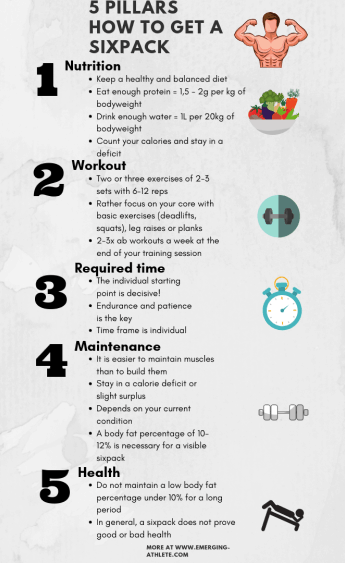
Nutrition
Overall, the most important thing is to have a natural, healthy and balanced diet. Focus on unprocessed food, eat lots of fruits and vegetables. Adequate water supply is also fundamental. As a rule of thumb, I recommend 1L of water for every 20kg of body weight.
Workout routine
During training, I recommend using a relatively low rep range between 6-12. In this area, the muscles respond best to muscle growth.
Please don’t waste your time doing hundreds of sit-ups and crunches every day. Schedule your abdominal training at the end of your training sessions to avoid injuries from lacking stabilization during compound exercises like squats or deadlifts.
I suggest 2-3 exercises for 2-4 sets per ab workout. It’s that simple.
Timescale
How long it takes to get a Six-pack depends on many different factors.
These are, as always, individual and can not be generalized. For one, your starting point is crucial, if you start with 10-12% body fat you will either already have a sixpack or it won’t take long.
Yet, if you start with 20-25% body fat, it can take a much longer.
The key is endurance and patience.
Maintaining
It does not take too much to keep your hard-won six-pack. It is important to find the area in which you hold your weight. Either a slight caloric deficit is necessary or you can even tackle a slight calorie surplus.
As always, this varies individually.
Health
Generally, a six-pack doesn’t say much about a person’s health.
As we have already mentioned, fat is a vital ingredient. That is why it is not healthy to sustain a state of 6% body fat for a long time. On the opposite, a healthy six-pack with a body fat percentage of 10-12% is not dangerous as well!
How do you approach your journey to your dream six-pack?
Engage with us in the comments below!
I hope this guide helps you to finally achieve your six-pack!
Cheers,
Claas

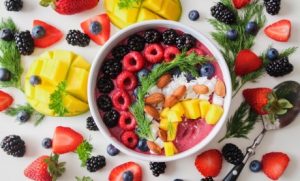

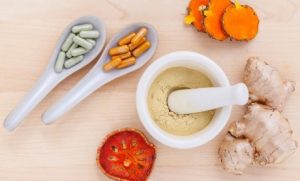

2 thoughts on “5 Tips How to Get a Sixpack”
Nice Post!
Thanks!